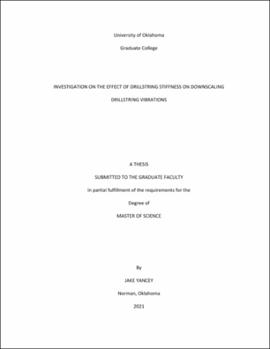| dc.description.abstract | Drillstring vibrations provide one of the most important challenges to drilling efficiency today. These vibrations can cause many issues such as decreased energy transfer from the to drive to the bit, fluctuating drilling parameters, and damage to the bit and formation. All of these issues will lead to additional time and money that must be invested in order to drill to the same depth, thereby limiting the wells that can be attempted. One of the most prevalent forms of these vibrations is torsional vibrations or stick-slip interactions. These vibrations occur in approximately fifty percent of drilling done today and thus are the most common type of major vibrations (Dufeyte & Henneuse 1991).
The objective of this thesis was to develop and test a small-scale model of torsional vibrations in order to permit the testing of various parameters and their impact on the occurrence and intensity of stick-slip interactions. By creating a reduced scale model, testing can be conducted in laboratories and for a much-reduced economic burden. Therefore, a 1.6 meter model of a drillstring based upon the Kyllingstad & Halsey (1988) torsional pendulum model was created. This model represents the drillstring in tension above the neutral point. However, in order to induce stick-slip interactions at this scale, steel could not be used. This is because its slip-stick index (SSI) was less than one for all speeds tested. Therefore, other materials must be utilized to allow the stick-slip interactions to occur. Therefore, this thesis compares four strings and their applicability to testing at this scale. These strings were made of aluminum, polyethylene, and nylon.
The method utilized in the testing of the model was to secure each string between a top drive and a brake which represented the torque provided by the formation. The string was then rotated by the top drive while the brake was engaged, leading to a period of time where the top of the string rotated while the bottom remained stationary (sticking). Then, once the torque from the brake was overcome, the bottom began to rotate again (slipping). The period of time that the sticking occurred was recorded and converted to the angle rotated by the top of the string. This value was then utilized to determine the measured shear modulus which was subsequently compared to the known value for the string material.
When comparing the measured shear moduli to the true shear moduli of the string materials, three of the strings had results which mirrored the real world. All of these strings had shear moduli that stayed consistent through various torques and speeds as well as were close to the true value for the material. However, two of the strings, Strings 1 and 3 (made of aluminum and nylon respectively), were restrained by low tolerances for applied torque and speed. This limits the applicability of their results for future testing. However, String 2, made of polyethylene, not only had accurate results but also was consistent over a wide range of speeds and torques. These factors combine to make this string the prime choice for future testing of stick-slip interactions and the effects of various parameters on their occurrence. | en_US |
